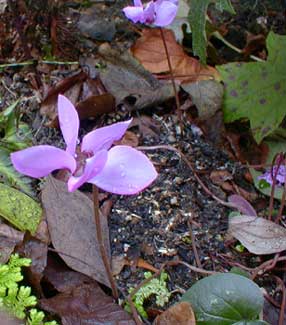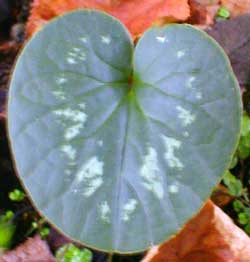
Cyclamen coum
'Rose Pink'
"The snail climbs the Doric
Line, & the empty snail shell
Lies by the wild cyclamen."
-Kenneth Rexroth
(1905-1982)
(1905-1982)
Of our many patches of Cyclamen coum the flowers for the majority look very similar. They all tend to have flowers in shades of pink, with also a white form, & a real fondness for multiple varieties tends to be more for the leaves, which range from plain shy green round to oval leaves, to mottled, to the more ornate pattern-leaf or pewtered varieties.
 For purposes of judging, assessing, & categorizing cyclamens by color, the gradations run from "white" to "shell" to "rose" to "magenta" to "crimson." Every shade from one extreme to the other exists, with a few blooms falling between Shell & Rose being difficult to dinfitively assign.
For purposes of judging, assessing, & categorizing cyclamens by color, the gradations run from "white" to "shell" to "rose" to "magenta" to "crimson." Every shade from one extreme to the other exists, with a few blooms falling between Shell & Rose being difficult to dinfitively assign.Due to cross-pollination, a single plant can throw off seedlings in every shade of pink, so to some degree the distinctions are illusory & do not necessarily define predictable strains. Even with careful breeding, a good deal of culling of seedlings is required to keep some aspect of a strain dominant.
Two which we obtained several years ago from Heronswood Nursery as seedlings were labeled 'Rose Pink' & 'Shell Pink.' If planted at any distance from one another they might not look all that dissimilar from one another, but planted side by side we can see that 'Rose Pink' has a darker violet-pink flower.
The February & March winter blossoms for the 'Rose' varies further with a more spidery-shaped or whirligig blossom. It is always a little surprising when 'Rose' unfolds its blooms to an inch wide from out of the tiniest bright pink buds which dotted the area with pink by January, weeks before they fully bloom. 'Shell' in comparison has a more fluffed out flower.
Though planted in identical conditions on the same day from seedlings started in the same month, 'Shell Pink' has every year been very leafy by mid-October, whereas 'Rose Pink' has only a few leaves starting at October's end, as shown in the second photo. 'Rose Pink' is robustly flowering late January through March, but holds back its full production of leaves until March, so the 'Shell' puts on the better leaf display Autumn through Spring.
Additionally, the leaves for 'Rose Pink' occur on long sometimes coiling stems, so that rather than a tight clump of leaves (as for the majority of our cyclamens) this particular 'Rose Pink' scatters its blooms & leaves thinly over a foot-wide surface. So too the flowers of 'Rose Pink' are on winding coiling stems that reach away from the center of the plant, while 'Shell Pink' has shorter more upright stems for its flowers. In the March portrait above, the coiling flower stems of 'Rose Pink' reach out from under the Oakleaf Hydrangea seeking a bit of sunlight.
If one set out to obtain a specimen like 'Rose Pink' with leaves & flowers on long stems reaching some distance from the center of the developing tuber, it would not be possible to do so predictably, because every seedling one obtains matures with its own characteristics.
The leaves on 'Rose Pink' have only the slightest markings, a very few whitish freckles circling the interior of the oval leaf, whereas nearby 'Shell Pink' has rounder leaves with the often-seen leafpattern of an arrow or fir tree. The fir-pattern for 'Shell Pink' appears in silhouette with dark green interior; the rest of the leaf is yellow-green outside the silhouette. It might not quite meet the definition of "Pattern-leaf" per se, as Pattern-leaf varieties tend to have their markings in silver, white, or pewter. The slight mottling for 'Rose Pink' would be regarded essentially as an intermediate plain-leaf, as a perfect plain-leaf has no marks at all.
It is fun to compare the 'Shell Pink' & 'Rose Pink' specimens because they are growing together with every aspect of their environment identical, & are identical in age, yet are so very different in the specifics of their apperance & behavior. These two are so near one another they will inevitably cross-pollinate, & produce future seedlings intermediate in leaf type, & all the more unpredictable when it comes to the color range of light to dark pinks, range of leaf appearance & behavior.
Continue to
Cyclamen coum, plain-leafed Magenta